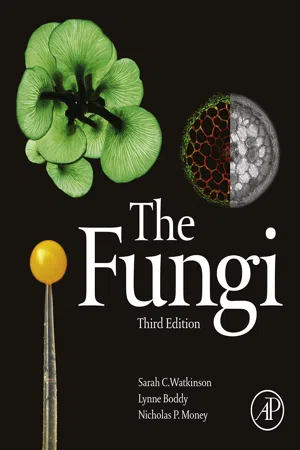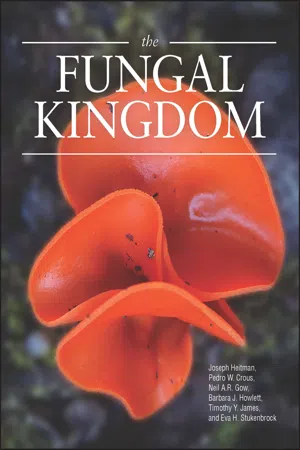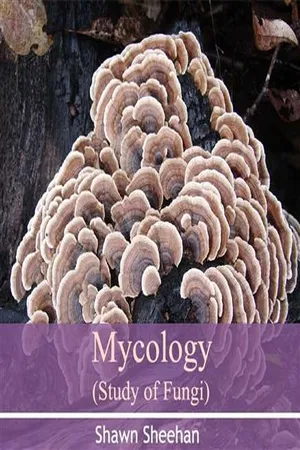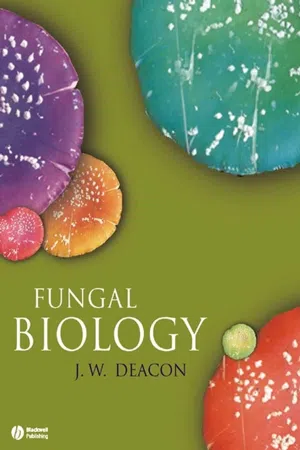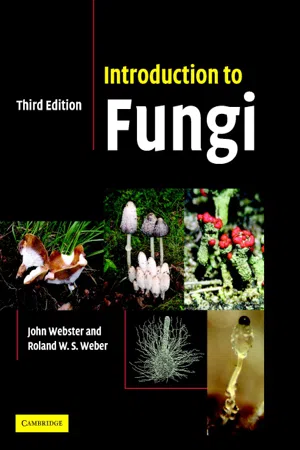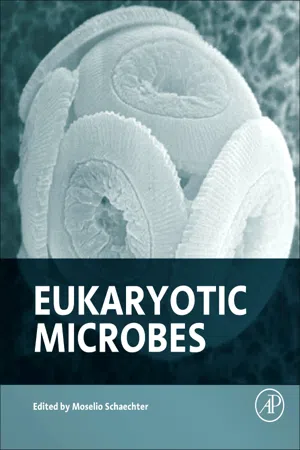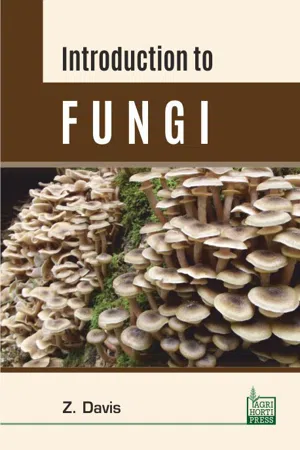Biological Sciences
Fungi Cell
Fungi cells are eukaryotic cells that make up the structure of fungi organisms. They contain membrane-bound organelles, including a nucleus, mitochondria, and endoplasmic reticulum. Fungi cells also have a cell wall made of chitin, which provides structural support and protection. These cells play a crucial role in the life cycle and functions of fungi, including reproduction and nutrient absorption.
Written by Perlego with AI-assistance
Related key terms
1 of 5
12 Key excerpts on "Fungi Cell"
- eBook - ePub
- Sarah C. Watkinson, Lynne Boddy, Nicholas Money(Authors)
- 2015(Publication Date)
- Academic Press(Publisher)
Chapter 2Fungal Cell Biology and Development
Nicholas P. Money Miami University, Oxford, OH, USAAbstract
Fungi share most fundamental features of cell structure and function with other eukaryotes. Cell biological distinctions include the unique chemical composition of the fungal cell wall and plasma membrane, and the peculiar mechanisms of hyphal growth in filamentous fungi and budding in yeasts. Filamentous fungi generate multicellular colonies, or mycelia, through the extension and repeated branching of cells called hyphae. Mycelia can be restricted to a patch on a decomposing leaf, or span an enormous territory in a forest ecosystem. Fungi also produce multicellular organs that function in the exploration of the environment and survival under conditions of environmental stress. Fruit bodies, including the familiar mushrooms of basidiomycetes, are multicellular reproductive organs. Mushroom formation involves the coordinated growth of millions of hyphae. The molecular control of hyphal growth and fruit body formation are areas of active research, but many questions about the developmental biology of the fungi are unanswered.Keywords Basidiomata Chitin Dolipore septum Ergosterol Hyphal tip growth Turgor pressure Rhizomorphs Septation Woronin bodies Yeast cell cycleOrganelles, Cells, Organs
Fungi are eukaryotes and much of their cell biology is shared with animals, plants, and protists. Fungal cells are built from the same kinds of organelles as other eukaryotes. They have a plasma membrane, nuclei, and complicated endomembrane system. Most species have mitochondria. A few organelles are not found in other kingdoms. These include a dense assembly of secretory vesicles called the Spitzenkörper that is located in hyphal tips, and the Woronin body of Ascomycota that serves as an intracellular plugging device that stops cytoplasmic leakage. The chitinous cell wall is another distinctive feature of fungal cells. This chapter will provide an overview of the structure of fungal cells, discuss how they grow and multiply to form yeast colonies or branching mycelia, and describe the developmental processes that result in the formation of complex, multicellular organs including cords, sclerotia, and mushrooms (Figure 2.1 - eBook - PDF
- Dilip K. Arora(Author)
- 2003(Publication Date)
- CRC Press(Publisher)
1 Cell Biology of Hyphae Oded Yarden The Hebrew University of Jerusalem, Rehovot, Israel 1 INTRODUCTION Members of the fungal kingdom are present in almost every conceivable niche. Even though fungi are remarkably diverse, many fungi share common cellular characteristics that are instrumental to the success of fungal growth, development, proliferation, and survival. The purpose of this introductory chapter is to provide the reader with an overview of some of the fundamental aspects of one of the predominant forms of fungal structures—hyphae. The introductory chapter discusses the attributes that are common to many fungi as well as other organisms while also emphasizing some of the features that are unique to fungal species, as compared to other eukaryotes (some of the details will be discussed in depth in the following chapters of this book). Perhaps the primary recognizable difference between the hyphal “cell” and cells of other organisms is the predominantly coenocytic nature of the former. Characteristically, the hyphal cell harbors multiple nuclei that are evenly or unevenly distributed over relatively long distances of cytoplasmic continuity. Nonetheless, in this chapter, the term “cell” is used while discussing some of the fundamental as well as more unique attributes of hyphae. Identifying and understanding the nature of these attributes, and in particular, the regulatory mechanisms involved in orchestrating the growth of the fungal filament is an important step in the process of our intervention in fungal biology, be it curbing detriments or enhancing benefits these organisms are capable of exhibiting. 2 THE CELL WALL The cell wall is a characteristic structure present in many organisms whose life style to grow in an environment with continuously changing water potential can be described as an absorptive one. - eBook - ePub
- Joseph Heitman, Barbara J. Howlett, Pedro W. Crous, Eva H. Stukenbrock, Timothy Yong James, Neil A. R. Gow(Authors)
- 2017(Publication Date)
- ASM Press(Publisher)
12 The Fungal Cell Wall: Structure, Biosynthesis, and FunctionNeil A. R. Gow,1 Jean-Paul Latge,2 and Carol A. Munro1INTRODUCTION
Fungal cell walls are dynamic structures that are essential for cell viability, morphogenesis, and pathogenesis. The wall is much more than the outer layer of the fungus; it is also a dynamic organelle whose composition greatly influences the ecology of the fungus and whose composition is highly regulated in response to environmental conditions and imposed stresses. A measure of the importance of the cell wall can be appreciated by the fact that approximately one-fifth of the yeast genome is devoted to the biosynthesis of the cell wall (1 , 2 ). Of these approximately 1,200 Saccharomyces cerevisiae genes (2 ), some are concerned with the assembly of the basic components, others provide substrates for wall materials, and many regulate the assembly process and couple this to environmental challenges. They include genes that encode carbohydrate active enzymes (which can be found in the CAZy database [http://www.cazy.org ]) (3 ) and include multigene families of chitin and glucan synthases as well as remodeling enzymes such as the glycohydrolases (glucanases, chitinases) and transglycosidases. Many of the building blocks of the cell wall are conserved in different fungal species (4 ), while other components of the wall are species-specific, and there is perhaps no part of the cell that exhibits more phenotypic diversity and plasticity than the cell wall.Walls are built to be both malleable and mechanically robust. The high total solute concentration inside fungal cells results in the osmotic uptake of water and the pressing of the cell membrane onto the wall. The resulting turgor pressure has been estimated to be between 0.2 and 10 MPa—equivalent to 2 to 20 times atmospheric pressure (5 ). The melanized cell walls of the appressoria of some plant pathogens such as Magnaporthe oryzae can withhold an internal turgor of up to 20 MPa. These cell walls are the most robust of all walls found in nature. Turgor pressure generates the force that enables hyphae to exert mechanical force on the substrates they are penetrating (5 , 6 ). Hyphal forces of between 0.01 and 0.1 μN/μm (5 - No longer available |Learn more
- (Author)
- 2014(Publication Date)
- Research World(Publisher)
This fungal group is distinct from the structurally similar myxo -mycetes (slime molds) and oomycetes (water molds). The discipline of biology devoted to the study of fungi is known as mycology, which is often regarded as a branch of botany, even though genetic studies have shown that fungi are more closely related to animals than to plants. Abundant worldwide, most fungi are inconspicuous becaus e of the small size of their structures, and their cryptic lifestyles in soil, on dead matter, and as symbionts of plants, animals, or other fungi. They may become noticeable when fruiting, either as mushrooms or molds. Fungi perform an essential role in the decomposition of organic matter and have fundamental roles in nutrient cycling and exchange. They have long been used as a direct source of food, such as mushrooms and truffles, as a leavening agent for bread, and in fermentation of various food product s, such as wine, beer, and soy sauce. Since the 1940s, fungi have been used for the production of antibiotics, and, more recently, various enzymes produced by fungi are used industrially and in detergents. Fungi are also used as biological pesticides to co ntrol weeds, plant diseases and insect pests. Many species produce bioactive compounds called mycotoxins, such as alkaloids and polyketides, that ________________________ WORLD TECHNOLOGIES ________________________ are toxic to animals including humans. The fruiting structures of a few species contain psychotropic compounds and are consumed recreationally or in traditional spiritual ceremonies. Fungi can break down manufactured materials and buildings, and become significant pathogens of humans and other animals. Losses of crops due to fungal diseases (e.g. rice blast diseas e) or food spoilage can have a large impact on human food supplies and local economies. - eBook - PDF
Fungi
Biology and Applications
- Kevin Kavanagh(Author)
- 2005(Publication Date)
- Wiley(Publisher)
Finally, because they are eukaryotic cells, they exhibit many of the properties and functions characteristic of human cells, and thus served as a better model for many cellular processes than the bacterial systems that had been investigated in depth previously. The advent of the molecular biological revolution in the 1970s strengthened the importance of fungal systems as models for genetic studies of eukaryotic cell function. Because each individual fungal cell was autonomous, transformation with external DNA allowed the efficient genetic engineering of an entire organ- ism. The rapid development of fungal transformation systems after the initial successes with S. cerevisiae, followed by the construction of efficient vectors for the transfer of genes and the cloning of the various components of chro- mosomes, allowed for effective genetic manipulation of fungal cells. Ultimately, this technology permits the construction of strains of fungi genetically designed to differ from a standard strain by as little as a single selected nucleotide. This chapter provides an overview of various aspects of fungi and their use as model organisms for genetic analysis. Representative species from the higher fungi, including ascomycetes and basidiomycetes, comprise the focus for dis- 36 FUNGAL GENETICS cussion, and comparisons between the yeasts (Saccharomyces cerevisiae) and the filamentous organisms (Neurospora crassa, Aspergillus nidulans, Coprinus cinereus) are emphasized to introduce both the advantages of particular systems and the diversity within the kingdom. Examples of dimorphic fungi, which live in both a yeast and filamentous form, are also discussed to highlight unique features and variations on themes within the fungi. 2.2 Fungal life cycles 2.2.1 Ascomycete yeast (Saccharomyces cerevisiae) S. cerevisiae is an extremely well studied organism, with a clearly defined and experimentally manipulable life cycle. - eBook - PDF
- J. W. Deacon(Author)
- 2009(Publication Date)
- Wiley-Blackwell(Publisher)
Chapter 3 Fungal structure and ultrastructure This chapter is divided into the following major sections: • the structure of a fungal hypha • fungal ultrastructure • the hypha as part of a colony • the structure of yeasts • fungal walls and wall components • septa • the fungal nucleus • cytoplasmic organelles • the fungal cytoskeleton and molecular motors Fungi have many unique features in terms of their struc- ture, cellular components, and cellular organization. These features are intimately linked to the mechanisms of fungal growth and therefore to the many activities of fungi as decomposer organisms, plant pathogens, and pathogens of humans. In this chapter we consider the main structural and ultrastructural features of fungi, and some of the powerful techniques that enable us to view the dynamics of subcellular com- ponents in living fungal hyphae, giving an insight into the way that fungi grow. Overview: the structure of a fungal hypha The hypha is essentially a tube with a rigid wall, con- taining a moving slug of protoplasm (Fig. 3.1). It is of indeterminate length but often has a fairly constant diameter, ranging from 2 µm to 30 µm or more (usu- ally 5–10 µm), depending on the species and growth conditions. Hyphae grow only at their tips, where there is a tapered region termed the extension zone; this can be up to 30 µm long in the fastest-growing hyphae such as Neurospora crassa which can extend at up to 40 µm per minute. Behind the growing tip, the hypha ages progressively and in the oldest regions it may break down by autolysis or be broken down by the enzymes of other organisms (heterolysis). While the tip is growing, the protoplasm moves continuously from the older regions of the hypha towards the tip. So, a fungal hypha continuously extends at one end and con- tinuously ages at the other end, drawing the protoplasm forward as it grows. - eBook - PDF
- John Webster, Roland Weber(Authors)
- 2007(Publication Date)
- Cambridge University Press(Publisher)
1 Introduction 1.1 What are fungi? About 80 000 to 120 000 species of fungi have been described to date, although the total number of species is estimated at around 1.5 million (Hawksworth, 2001; Kirk et al ., 2001). This would render fungi one of the least-explored biodiversity resources of our planet. It is notoriously difficult to delimit fungi as a group against other eukary-otes, and debates over the inclusion or exclusion of certain groups have been going on for well over a century. In recent years, the main arguments have been between taxonomists striving towards a phylogenetic definition based especially on the similarity of relevant DNA sequences, and others who take a biological approach to the subject and regard fungi as organisms sharing all or many key ecological or physiological characteristics the ‘union of fungi’ (Barr, 1992). Being interested mainly in the way fungi function in nature and in the laboratory, we take the latter approach and include several groups in this book which are now known to have arisen independently of the mono-phyletic ‘true fungi’ ( Eumycota ) and have been placed outside them in recent classification schemes (see Fig. 1.25). The most important of these ‘pseudofungi’ are the Oomycota (see Chapter 5). Based on their lifestyle, fungi may be circumscribed by the following set of characteristics (modified from Ainsworth, 1973): 1. Nutrition . Heterotrophic (lacking photosyn-thesis), feeding by absorption rather than ingestion. 2. Vegetative state . On or in the substratum, typically as a non-motile mycelium of hyphae showing internal protoplasmic streaming. Motile reproductive states may occur. 3. Cell wall . Typically present, usually based on glucans and chitin, rarely on glucans and cellulose (Oomycota). 4. Nuclear status . Eukaryotic, uni-or multi-nucleate, the thallus being homo-or hetero-karyotic, haploid, dikaryotic or diploid, the latter usually of short duration (but excep-tions are known from several taxonomic groups). - eBook - PDF
- Moselio Schaechter(Author)
- 2011(Publication Date)
- Academic Press(Publisher)
The transmission electron micrograph is of a Candida albicans cell. BS, bud scar; CM, cell membrane; CMI, cell membrane invagination; CW, cell wall; ER, en-doplasmic reticulum; M, mitochondrion; N, nucleus; and V, vacuole. Courtesy of M. Osumi, Japan Women’s University, Tokyo. TABLE 4 Functional components of an ideal yeast cell Organelle or cellular structure Function Cell envelope Comprises the plasma membrane that acts as a selectively permeable barrier for transport of hydrophilic molecules in and out of fungal cells; the periplasm containing proteins and enzymes unable to permeate the cell wall; the cell wall that provides protection and shape and is involved in cell–cell interactions, signal reception, and specialized enzyme activities; fimbriae involved in sexual conjugation; and capsules to protect cells from dehydration and immune cell attack Nucleus Contains chromosomes (DNA–protein complexes) that pass genetic information to daughter cells during cell division and the nucleolus, which is the site of ribosomal RNA transcription and processing Mitochondria Responsible, under aerobic conditions, for respiratory metabolism and, under anaerobic conditions, for fatty acid, sterol, and amino acid metabolism Endoplasmic reticulum Ribosomes on the rough endoplasmic reticulum are the sites of protein biosyntheses (translation of mRNA nucleotide sequences into amino acid sequences in a polypeptide chain) Proteasome Multi-subunit protease complexes involved in regulating protein turnover Golgi apparatus and vesicles Secretory system for import (endocytosis) and export (exocytosis) of proteins Vacuole Intracellular reservoir (amino acids, polyphosphate, and metal ions), proteolysis, protein trafficking, and control of intracellular pH Peroxisome Present in some methylotrophic (methanol-utilizing) yeasts for oxidative utilization of specific carbon and nitrogen sources (contain catalase and oxidases). - No longer available |Learn more
- (Author)
- 2014(Publication Date)
- Academic Studio(Publisher)
They reproduce by both sexual and asexual means, and like basal plant groups (such as ferns and mosses) produce spores. Similar to mosses and algae, fungi typically have haploid nuclei. • With euglenoids and bacteria: Higher fungi, euglenoids, and some bacteria produce the amino acid L -lysine in specific biosynthesis steps, called the α -aminoadipate pathway. • The cells of most fungi grow as tubular, elongated, and thread-like (filamentous) structures and are called hyphae, which may contain multiple nuclei and extend at their tips. Each tip contains a set of aggregated vesicles—cellular structures consisting of proteins, lipids, and other organic molecules—called Spitzenkörper. Both fungi and oomycetes grow as filamentous hyphal cells. In contrast, similar -looking organisms, such as filamentous green algae, grow by repeated cell division within a chain of cells. • In common with some plant and animal species, more than 60 fungal species display the phenomenon of bioluminescence. Unique features: • Some species grow as single-celled yeasts that reproduce by budding or binary fission. Dimorphic fungi can switch between a yeast phase and a hyphal phase in response to environmental conditions. • The fungal cell wall is composed of glucans and chitin; while the former compounds are also found in plants and the latter in the exoskeleton of arthropods, fungi are the only organisms that combine these two structural molecules in their cell wall. In contrast to plants and the oomycetes, fungal cell walls do not contain cellulose. ________________________ WORLD TECHNOLOGIES ________________________ Omphalotus nidiformis , a bioluminescent mushroom Most fungi lack an efficient system for long-distance transport of water and nutrients, such as the xylem and phloem in many plants. To overcome these limitations, some fungi, such as Armillaria , form rhizomorphs, that resemble and perform functions similar to the roots of plants. - eBook - PDF
- N A Khan(Author)
- 2008(Publication Date)
- CRC Press(Publisher)
Other polysaccharides found in fungi are chitosan (polymers of D-glucosamine), a-glucan (polymers of D-glucose), p-glucan (poly mers of D-glucose), mannan (polymers of D-mannose), galactans (poly 240 241 mers of D-galactose) and small amounts of fucose, rhamnose, xylose and uronic acids. Their functions reside in providing shape, rigidity, strength and pro tection from osmotic shock. They are antigenic in nature (i.e., induce antibody response). 2. Cell membrane The cell membrane is made of a lipid bilayer. In contrast to other eukaryotes, the cell membrane of fungi contains ergosterol or zymosterol instead of cholesterol. The functions of cytoplasm include regulating material/fluid diffusion in and out of the cell as well as active transportation and facilitating capsule and cell wall synthesis. 3. Cytoplasm containing nucleus with chromosomes, nuclear membrane, nucleolus, endoplasmic reticulum, mitochondria, Golgi apparatus, vacuoles, ribosomal RNA and a cytoskeleton with microtubules composed of tubulin, intermediate filaments and microfilaments composed of actin. Their genome size is considerably smaller than other eukaryotes. For example, the genome size of Saccharomyces cerevisiae is approx. 13.5 Mbp as compared to E. coli that is around 5 Mbp, Drosophila is 165 Mbp and humans is 2900 Mbp. Apart from chromosomal genes, they also possess mitochondrial DNA, plasmids and mobile genetic elements. Similar to other eukaryotes, their genes contain non-coding regions, introns but shorter (around 100 bp) than other higher eukaryotes (around 10 kbp). 4. FEEDING Fungi obtain their food by secreting hydrolytic enzymes, digesting their food externally and absorbing it. They obtain their food using three mechanisms. 1. Saprophytes -in this group, fungi use dead organic materials such as plants, animals, other microbes, etc. 2. Symbiosis -fungi live with their living host to the benefit of the host. - eBook - PDF
- Lynne Boddy, Juliet Frankland, Pieter van West(Authors)
- 2007(Publication Date)
- Academic Press(Publisher)
Fungal morphogenesis must be totally different from animals, because fungal cells have walls, and from plants (whose cells also have walls) because hyphae grow only at their tips and hyphal cross-walls form only at right angles to the Fruit Bodies 81 Figure 1 Flowchart showing a simplified view of the processes involved in development of fruit bodies and other multicellular structures in fungi (from Moore, 1998a). David Moore et al. 82 Table 1 The eleven principles that govern fungal development Principle 1 The fundamental cell biology of fungi on which development depends is that hyphae extend only at their apex, and cross-walls form only at right angles to the long axis of the hypha Principle 2 Fungal morphogenesis depends on the placement of hyphal branches Principle 3 The molecular biology of the management of cell-to-cell interactions in fungi is completely different from that found in animals and plants Principle 4 Fungal morphogenetic programmes are organised into developmental subroutines, which are integrated collections of genetic information that contribute to individual isolated features of the whole programme. - eBook - PDF
- Davis, Z(Authors)
- 2021(Publication Date)
- Agri Horti Press(Publisher)
Brief Descriptions of Microorganisms Bacteria are relatively simple, prokaryotic organisms whose cells lack a nucleus or nuclear membrane. The bacteria may appear as rods, spheres, or spirals. Bacteria reproduce by binary fission, have unique constituents in their cell walls, and exist in most environments on earth. For instance, they live at temperatures ranging from 0° to 100°C and in conditions that are oxygen rich or oxygen free. A microscope is necessary to see and study them. Fungi are eukaryotic microorganisms that include multicellular molds and unicellular yeasts. The yeasts are slightly larger than bacteria and are used in alcoholic fermentations and bread making. Certain yeasts such as Candida albicans are pathogenic. Molds are filamentous, branched fungi that use spores for reproduction. The fungi prefer acidic environments, and most live at room temperature under oxygen-rich conditions. The common mushroom is a fungus. Protozoa are eukaryotic, unicellular organisms. Motion is a characteristic associated with many species, and the protozoa can be classified just as to how they move: Some protozoa use This ebook is exclusively for this university only. Cannot be resold/distributed. 226 Introduction to Fungi flagella, others use cilia, and others use pseudopodia. Certain species are nonmotile. Protozoa exist in an infinite variety of shapes because they have no cell walls. Many species cause such human diseases as malaria, sleeping sickness, dysentery, and toxoplasmosis. The term algae implies a variety of plantlike organisms. In microbiology, several types of single-celled algae are important. Examples are the diatoms and dinoflagellates that inhabit the oceans and are found at the bases of marine food chains. Most algae capture sunlight and transform it to the chemical energy of carbohydrates in the process of photosynthesis. Viruses are ultramicroscopic bits of genetic material enclosed in a protein shell and, sometimes, a membranous envelope.
Index pages curate the most relevant extracts from our library of academic textbooks. They’ve been created using an in-house natural language model (NLM), each adding context and meaning to key research topics.
